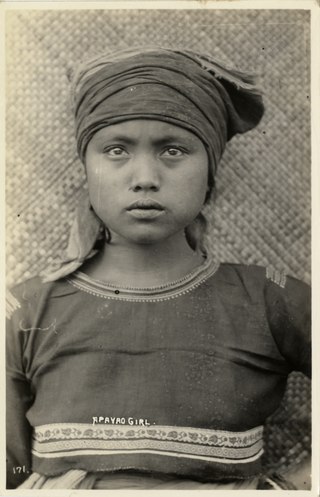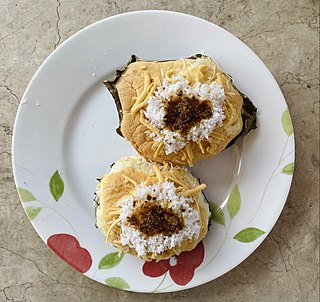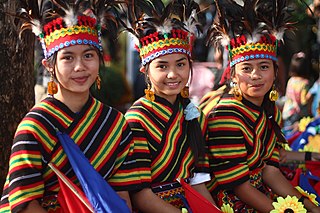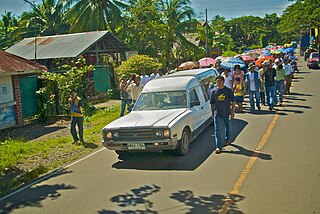Related Research Articles

Glutinous rice is a type of rice grown mainly in Southeast and East Asia, and the northeastern regions of South Asia, which has opaque grains, very low amylose content, and is especially sticky when cooked. It is widely consumed across Asia.

The Ibaloi are an indigenous ethnic group found in Benguet province of the northern Philippines. Ibaloi is derived from i-, a prefix signifying "pertaining to" and badoy or house, together then meaning "people who live in houses". The Ibaloi are one of the indigenous peoples collectively known as Igorot, who live in the cordillera central of Luzon.

Filipino cuisine is composed of the cuisines of more than a hundred distinct ethnolinguistic groups found throughout the Philippine archipelago. A majority of mainstream Filipino dishes that compose Filipino cuisine are from the food traditions of various ethnolinguistic groups and tribes of the archipelago, including the Ilocano, Pangasinan, Kapampangan, Tagalog, Bicolano, Visayan, Chavacano and Maranao ethnolinguistic groups. The dishes associated with these groups evolved over the centuries from a largely indigenous base shared with maritime Southeast Asia with varied influences from Chinese, Spanish and American cuisines, in line with the major waves of influence that had enriched the cultures of the archipelago and adapted using indigenous ingredients to meet local preferences.

Gawai Dayak is an annual festival and a public holiday celebrated by the Dayak people in Sarawak, Malaysia on 1 and 2 June. Sarawak Day is now celebrated on July 22 every year. Gawai Dayak was conceived of by the radio producers Tan Kingsley and Owen Liang and then taken up by the Dayak community. The British colonial government refused to recognise Dayak Day until 1962. They called it Sarawak Day for the inclusion of all Sarawakians as a national day, regardless of ethnic origin. It is both a religious and a social occasion recognised since 1957.

The Isnag people are an Austronesian ethnic group native to Apayao province in the Philippines' Cordillera Administrative Region. Their native language is Isneg, although most Isnag also speak Ilocano.

The Ilocanos, Ilokanos, or Iloko people are the third largest Filipino ethnolinguistic group. They mostly reside within the Ilocos Region, in the northwestern seaboard of Luzon, Philippines. The native language of the Ilocano people is the Ilocano language.

Nian gao, sometimes translated as year cake or New Year cake or Chinese New Year's cake, is a food prepared from glutinous rice flour and consumed in Chinese cuisine. It is also simply known as "rice cake". While it can be eaten all year round, traditionally it is most popular during the Chinese New Year. It is considered good luck to eat nian gao during this time of the year because nian gao (年糕) is a homonym for "higher year" or "grow every year" (年高), which means "a more prosperous year". The character 年 is literally translated as "year", and the character 糕 (gāo) is literally translated as "cake" and is identical in sound to the character 高, meaning "tall" or "high". Nian gao (年糕) also is an exact homonym of "sticky cake" (黏糕/粘糕), the character 黏/粘 (nián) meaning "sticky".

Bibingka commonly refers to a type of baked rice cake from the Philippines that is traditionally cooked in a terracotta oven lined with banana leaves and is usually eaten for breakfast or as merienda especially during the Christmas season.

Puto is a Filipino steamed rice cake, traditionally made from slightly fermented rice dough (galapong). It is eaten as is or as an accompaniment to a number of savoury dishes. Puto is also an umbrella term for various kinds of indigenous steamed cakes, including those made without rice. It is a sub-type of kakanin.

The Ifugao people are the ethnic group inhabiting Ifugao province in the Philippines. They reside in the municipalities of Lagawe, Aguinaldo, Alfonso Lista, Asipulo, Banaue, Hingyon, Hungduan, Kiangan, Lamut, Mayoyao, and Tinoc. The province is one of the smallest provinces in the Philippines with an area of only 251,778 hectares, or about 0.8% of the total Philippine land area. As of 1995, the population of the Ifugaos was counted to be 131,635. Although the majority of them are still in Ifugao province, some of them have moved to Baguio, where they work as woodcarvers, and to other parts of the Cordillera Region.

During the Pre-Hispanic period the early Filipinos believed in a concept of life after death. This belief, which stemmed from indigenous ancestral veneration and was strengthened by strong family and community relations within tribes, prompted the Filipinos to create burial customs to honor the dead through prayers and rituals. Due to different cultures from various regions of the Philippines, many different burial practices have emerged. For example, the Manobos buried their dead in trees, the Ifugaos seated the corpse on a chari before it was brought to a cave and buried elsewhere. The most common forms of traditional burials are supine pits, earthenware jars, and log coffins, and have been a topic of interest among Philippine archaeologists since the early 20th century.

Sticky rice in bamboo is a common Southeast Asian dish consisting of sticky rice roasted inside specially prepared bamboo sections of different diameters and lengths. It is consumed both as a savory food and as a sweet dessert.

The Kankanaey people are an Indigenous peoples of the Northern Philippines. They are part of the collective group of indigenous people known as the Igorot people.

Biko is a sweet rice cake from the Philippines. It is made of coconut milk, brown sugar, and sticky rice. It is usually topped with latik. It is a type of kalamay dish and is prepared similarly, except the rice grains are not ground into a paste. They are also sometimes packaged and sold as suman.
Ancient diet is mainly determined by food's accessibility which involves location, geography and climate while ancient health is affected by food consumption apart from external factors such as diseases and plagues. There are still a lot of doubt about this ancient diet due to lack of evidence. Similar to what anthropologist Amanda Henry has said, there are a lot of time periods in the human history but there are only theories to answer questions on what people actually ate then. Only recently have traces been discovered in what was left of these people.

Ketupat, or kupat, or tipat is a Javanese rice cake packed inside a diamond-shaped container of woven palm leaf pouch, Originating in Indonesia, it is also found in Brunei, Malaysia, Singapore and southern Thailand. It is commonly described as "packed rice", although there are other types of similar packed rice such as lontong and bakchang.
Krayasat, is a Thai dessert prepared for Buddhist religious events. It is commonly served during the Festival of Offerings to the Dead, a Thai holiday. It is made from peanuts, sugar cane, sticky rice, sesame and coconut. Krayasat is similar in appearance to a granola bar, but with a sweeter taste and very sticky.

Filipino American cuisine has been present in America ever since Filipinos moved there, but only recently has the Filipino food become more widely popular. Filipino food has gone through its evolution of adapting other cultures' food practices into their own, or borrowing the food concept into their own.

Pusô or tamu, sometimes known in Philippine English as "hanging rice", is a Filipino rice cake made by boiling rice in a woven pouch of palm leaves. It is most commonly found in octahedral, diamond, or rectangular shapes, but it can also come in various other intricately woven complex forms. It is known under many different names throughout the Philippines with numerous variations, but it is usually associated with the street food cultures of the Visayan and Moro peoples.

Anito, also spelled anitu, refers to ancestor spirits, nature spirits, and deities in the indigenous Philippine folk religions from the precolonial age to the present, although the term itself may have other meanings and associations depending on the Filipino ethnic group. It can also refer to carved humanoid figures, the taotao, made of wood, stone, or ivory, that represent these spirits. Anito is also sometimes known as diwata in certain ethnic groups.
References
- ↑ Gov.ph (25 May 2020). "NATIONAL HERITAGE MONTH 2020 – TRADITION OF ATANG".
- ↑ Virgil Mayor Apostol (2010). "Way of the Ancient Healer: Sacred Teachings from the Philippines": 22.
This is a practice that has its roots in the ancient custom of constructing a home that includes an atang made before, during, ... An atang set for the one-year death anniversary of engineer and Arnis master Eduardo Vintayen. ...
{{cite journal}}: Cite journal requires|journal=(help) - ↑ Philippine Journal of Education. 1974.
Occasionally, after harvest time, she could be seen offering an "atang" (food: rice and native cakes) in a corner of her rice field chanting her thanks to the "anitos" and "encantos" for the good harvest and praying for a better harvest ...
{{cite journal}}: Missing or empty|title=(help) - ↑ Jocano, F. Landa; Edrozo, Arnora (1982). "The Ilocanos: an ethnography of family and community life in the ...". University of the Philippines. Asian Center.
The family also makes an atang (food offering) before each meal. No one eats before this is otherwise, a member of the household or any guest for that matter will have deformed mouth, lockjaw, or stomachache. Only when the spirits are ...
{{cite journal}}: Cite journal requires|journal=(help) - ↑ Duque, Venancio S. (February 1937). "Santorum". Philippine Magazine. 32 (2): 216–220. doi:10.2307/1177391. JSTOR 1177391.
Santorum is a name given to a certain weird and mystic ceremony performed by native medicos in northern Luzon and in the central provinces to cure those who are said to be suffering from ailments wrought by the spirits.
A santorum, sometimes called a pañang, was performed for the treatment of one of the writer's acquaintances after the attending physician had given up all hope for his recovery. - ↑ "Studies in Philippine linguistics". Linguistic Society of the Philippines: Summer Institute of Linguistics. 1988.
The only type of dance ever mentioned by the people is the atang. (An atang was put on once for our benefit ... Now that feuds more and more are settled peacefully, at least near the coast, an atang is sometimes staged by a single ...
{{cite journal}}: Cite journal requires|journal=(help) - 1 2 "Undas 2021 (Atang)". National Museum. 2021-11-02. Retrieved 2021-11-04.
- ↑ Dunuan, Liezl (2016-10-03). "LOOK: The 'Atang' As An Ilocano Ritual of Remembrance". Pilipinas Popcorn. Retrieved 2021-11-04.